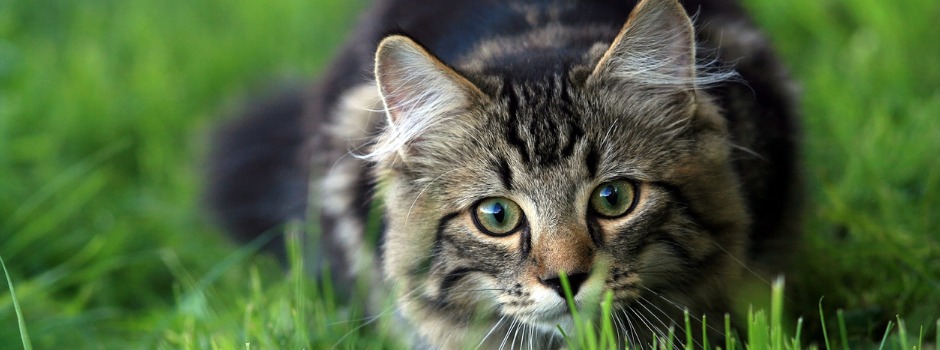Are you a dog or cat person? Does a dog’s eager friendliness make him superior to an elegantly aloof feline, or vice versa? It’s a debate that has divided animal lovers for generations.

BBC documentary is seeking to resolve the question by discovering definitively which species has the edge: Britain’s eight million cats, or its nine million canines.
In Cats Vs Dogs, animal experts Chris Packham and Liz Bonnin team up with scientists and vets to put our two favourite pets to the test in a host of different categories.
Think you know which one will win? Don’t bet on it. Here are some of the findings…
DOGGED DEVOTION
Dogs: Almost everything dogs do, from excitedly greeting their owner at the door to lying loyally at their feet, seems to be indisputable evidence of their love.
Cats, on the other hand, are more inscrutable and independent. They decide when their owners are granted a stroke or cuddle. Most owners, however, are convinced their puss loves them but just aren’t as demonstrative as dogs.
But are they right? Scientists have already discovered that dogs do seem to love their owners – studies have found that both produce the ‘love hormone’ oxytocin when together. It’s the same hormone that pregnant women release during birth and breastfeeding to help them bond with their baby.
But cats have never been tested for this. So the show asked U.S. neuroscientist Dr Paul Zak to test both types of animal to solve the eternal question.
“We have pretty good evidence that dogs actually love their humans,” he says. “A couple of small-scale studies have shown that when owners interact with their dogs, the human and their dog appear to release oxytocin.
“It’s one of the chemical measures of love in mammals. Humans produce the hormone in our brains when we care about someone. For example, when we see our spouse or child the levels in our blood stream typically rise by 40-60 per cent.”
Cats: For the new experiment, ten dogs and ten cats had saliva samples taken before playing with their owners for ten minutes. Afterwards, another saliva sample was taken and tested for the presence of oxytocin.
The results were astonishing: dogs showed an average increase in the hormone of 57.2 per cent, but cats just 12 per cent.
“From this sample it’s true to say that these dogs love their owners five times more than the cats do,” says Dr Zak.
“I was really surprised to discover that dogs produced such high levels of oxytocin.
“It was also a nice surprise to discover that cats produce any at all. At least some of the time, cats seem to bond with their owners.
“But the dog level of 57.2 per cent is a very powerful response. It shows these dogs really care about their owners. One dog – a sweet little lapdog – peaked at 500 per cent. It was totally in love with its owner.
“When it comes to how much dogs love us, there doesn’t seem to be any difference between breeds or sexes. But you can definitely strengthen that loving bond by petting and talking to your pet, particularly when he’s a puppy. And dogs definitely have favourites within the family. I am confident my own dog produces more oxytocin when I play with her than when anyone else does.”
So it’s conclusive – people’s cats do love them. They just don’t love them nearly as much as a dog does.
TEACHING A TABBY
They round up sheep, fetch our slippers; even guide the blind. Their capabilities seem almost limitless. But then again, dogs have been practising for millennia.
As long as 35,000 years ago, humans first spotted how good wolves were at hunting and began to domesticate them so they could harness their abilities.
Since then, they’ve evolved into the domesticated dogs we keep as pets – and we’ve bred only the most trainable, so the species is dedicated to obeying our every word. By contrast, cats became domesticated 10,000 years ago and have never been bred to be trained.
But cat expert Dr Sarah Ellis believes it is possible, – she’s taught her cat Cosmo to ring a bell to come into the house, and to change TV channels.
It was done in small steps – first rewarding Cosmo with a treat for sniffing the remote, then for touching it, and finally for achieving the task.
“Cats can be trained to do anything they’re physically capable of,” says Sarah. All they need is those incremental rewards until the goal is reached.
Dogs, however, remain superior learners. But why are they so trainable?
At the Family Dog Laboratory in Budapest, Hungary, they are performing groundbreaking research on canine brains to find answers.
There, dogs have been trained to lie completely still – not even wagging their tail – for the eight minutes it takes to complete a brain scan (if they move by so much as 3mm, it would ruin the experiment).
While inside the scanner, they listen to recordings of their owners praising them. Scientists discovered that, on hearing phrases like ‘good boy’, the reward regions in the brain that signal something pleasurable has just happened are activated.
It’s the same area that responds to food, drink and sex, proving that dogs find verbal praise as good as a mouth-watering treat.
“These results are hugely significant because they reveal that dogs get pleasure from our praise,” says Chris Packham. “So in turn, they’re motivated to please us and it’s that that makes them so eminently trainable.” As cats were ‘only’ domesticated 10,000 years ago and have never been expected to obey our commands, it’s not surprising they lag behind in the training stakes.

WHO’S A CLEVER BOY?
So which species is more intelligent – cats or dogs?
It’s long been thought that canines might be able to count because they were once pack-dwelling animals who would need to know if another pack they came across was bigger than theirs to avoid conflict.
So the Clever Dog Laboratory in Vienna – yes, it really exists – devised an experiment to find out. They flashed up two images in front of a dog – one showed many black dots on a white background, the other of just one or two dots. Every time the dog touched the screen showing many, he got a food treat. One husky called Luna scored an impressive nine out of 12.
But when the test became more complicated with more dots in each image, more densely packed (though one always had less), she struggled. Luna got just six out of ten correct.
“They can discriminate between different quantities,” says the lab’s Dr Friederike Range, “but it’s nothing to do with counting.”
Similar, although less high-tech, tests were performed with cats at the Animal Behaviour Clinic in Lincoln. A cat was taught the difference between one and four black shapes placed on a whiteboard and was rewarded every time she picked the bigger number. She got it right four out of five times.
When it was changed to three and six shapes, she picked correctly two out of three times then wandered off, refusing to return.
“I wouldn’t be surprised if cats had some concept of counting, but when’s a cat going to need to count up to ten?” says the centre’s Professor Daniel Mills.
Further research conducted by consultant vet Dick White found that, comparatively, dogs’ brains were 20 per cent larger than cats.
But the number of neuron cells in the brain are thought to be a better indicator of intelligence than sheer size. Dogs are thought to have 600m cortical neurons, compared with 300m in cats.
“It suggests they ought to be twice as intelligent as the cat,” says Professor White.
HIGH ACHIEVERS
Taking a similar-sized dog and cat, Matthew Pead, of the Royal Veterinary College, sought to discover which species can jump the highest.
The cat was a clear winner – soaring 50in (127cm) into the air while the dog only managed 44in (112cm). The highest cat jump ever recorded is 77in (196cm). “The dog is probably performing at the limit of what he can do,” says Dr Pead, “whereas I think the cat’s taking it easy.”
Given that both jump with the same technique, why is the cat so much better?
“The cat’s got an incredibly long reach,” explains Dr Pead. “They have relatively long bones in relation to their size – that gives them long levers, and long levers with long muscles means that you can generate a lot of force (to jump up with).”
Cat bones are also much lighter than dogs’ because they contain larger cavities. Their spines are more supple, increasing their ability to crouch then explode into a jump.
“The cat can pretty much push itself straight up in the air like a rocket,” says Dr Pead.
SIGHT FIGHT
Cats are known for their great night-time vision – after all, they’re predators hunting mainly nocturnal creatures. But how do dogs measure up?
Rick Sanchez, of the Royal Veterinary College, devised a maze for both species to negotiate in pitch darkness. They were let in at one end and only had their owner’s voice to guide them to the exit.
Whereas the dog seemed confused and often retraced his steps, the cat wandered through as if in broad daylight, taking just eight seconds compared with her canine rival’s 43 seconds.
So what’s the cat’s secret? While both creatures have reflective layers in the back of the eye called the tapetum, the cat has about 20 layers compared with the dog’s ten.
“And it’s oriented in such a way that it reflects light a lot more efficiently than a dog,” says Mr Sanchez. “The more light you’re able to reflect, the better you can see at night.”
Despite the dogs’ inferior night vision, it’s still five times better than a human’s.
THE SNIFF TEST
From their capacity to sniff out drugs, pick up trails and even scent disease, dogs’ extraordinary sense of smell is well known.
But how does it compare with that of cats? Pieter Nelissen, a specialist in small animal surgery, reveals that a canine’s olfactory epithelium (the rolled up scrolls of tissue in their noses) measures about 90sq cm – 30 times bigger than a human’s.
A cat’s epithelium is also larger than their owner’s at 20sq cm, but still much smaller than their canine counterparts. It also has fewer smell receptors – 60m compared with 150m, so overall dogs have the much better sense of smell.
But cats have one advantage over dogs in the smell challenge: the vomeronasal organ in their heads which picks up on chemical messages, or pheromones, from other felines is much more powerful and sophisticated than that of dogs.
So cats have the advantage in detecting where other felines are, and deciding whether to stay away or interact with them.
LISTEN UP
Any owner will tell you their pet has selective hearing – ignoring you when you order them to stop doing something they like but coming running at the merest hint of food. But which one has the best?
While dogs’ hearing is two or three times better than human’s, cats win hands down. An experiment by vet Dick White found that while both animals can hear a noise at 50 kilohertz – 10kHz is within human hearing – a cat responds to noises at 60kHz.
That’s because it has a very erect and mobile outer ear. He says: “It acts like a radar dish to collect the sound waves and directs them down to the tympanic membrane (eardrum).”
The cat’s middle ear chamber is also relatively larger than a dog’s which is why it’s thought to be able to hear a wider range of frequencies. But in the wild it needs to – the small animals moggies prey on tend to make high-pitched noises which helps the cat locate their dinner.
Dogs simply need to pester their owners for food.











